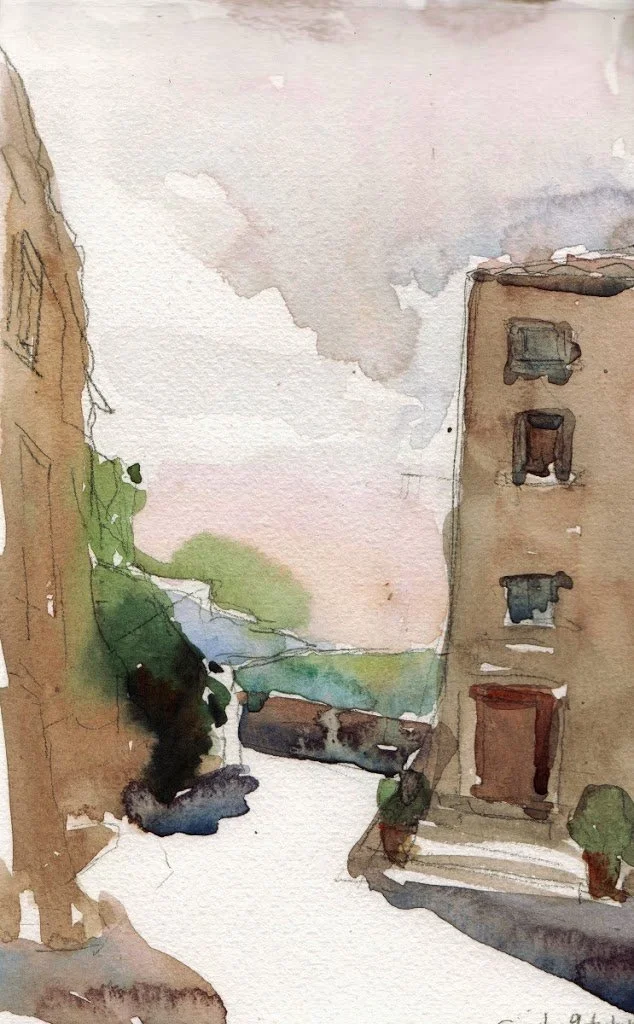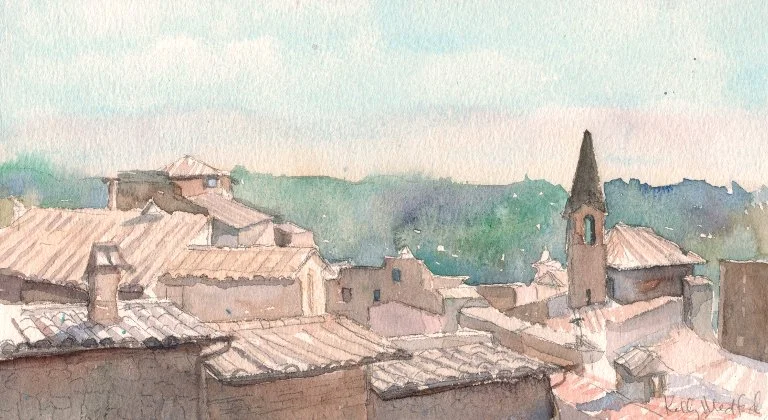Transcending the Italian Postcard
I was asked to give a talk about painting specifically in watercolor and teaching in an upcoming symposium next month in Perugia, Umbria, Italy. Before the talk I needed to prepare a short essay that would be included in a publication of all of the artists on the panel. Putting visual process and thoughts into writing is no simple task for an (or at least this) artist.
Below is the article that I have written for the publication and is a prelude for what will be my longer and more in depth talk in March. I thought to share my thoughts with you and it is always very helpful to look back at one’s process and devleopment over time.
One thing I have come to realize through both painting and teaching is that learning to paint light rather than objects, places and things is a big challenge and one that I address constantly both with myself and in teaching. We always want to explain everything, but there is an irony in this, which is mostly that we loose our way in finding our individual voice in the process.
I am really looking forward to the opportunity to give this talk, below are the condensed thoughts for publication with a few watercolors showing my progress over time.
Anyone interested in attending the talk, it will be held on March 15th in the Aula Magna of Universita’ per Stanieri di Perugia from 8:30 am – 7:30 pm and the symposium will feature wonderful international artists working in Umbria.
Here is my article entitled Transcending the Italian Postcard:
Why do we feel the need to document a place? Do we want to prove we were there?
Maybe there is nothing wrong with this urge, but it can result in postcard images that aren’t connected to our individual way of seeing the world. When we approach painting like this we are just accessing a collective store of images that seem to sum up Italy, like the thousands of pictures of La Capella della Madonna di Viteleta which we have all seen and loved. As an American artist coming to Italy this was a problem I faced. I would like to talk about how watercolors helped me overcome it.
I think of myself primarily as an oil painter, but I have always studied watercolor as was required in art school. Early on I felt that I did not quite have a handle on the medium. I never seemed to be able to enter the mindset required to master the moving around of pigment and water, it always had the upper hand and remained elusive.
Then in the summer of 2014 I took a workshop from a dear friend and architect who was teaching in Civita di Bagnoregio. I went to practice perspective drawing and hopefully deepen my theoretical understanding. Instead I found my voice in watercolor. On that trip I discovered the joy of painting in watercolor.
An exercise in making 10 minute watercolors changed my relationship to this medium forever. It all suddenly clicked. I no longer treated watercolor as I would oil. When I didn’t have time to go back over the image I realized the trick to watercolor: making strong, quick decisions and accepting the outcome along with its limitations, mistakes and imperfections.
This was my moment of liberation and it gave me new insights into myself as an artist and teacher. I saw that my training in classical ateliers, with figurative painters and traditional training, had given me the idea that art is inextricably linked to the perfectly accurate rendering of shapes, local color and so on. The missing elements were my personal mishaps, imperfections, ticks, mistakes and intuitive mark marking. In short, my individual personality and vision.
Civita di Bagnoregio
Watercolor on Paper, 2014
Over the years, I have continued to paint in watercolors, but I have only recently begun to consider myself both a watercolorist and an oil painter. In a sense, I still give less weight and importance to watercolor because of its size, immediacy, and because it is work on paper. But this doesn’t mean that I don’t take it seriously. I make this distinction in order to maintain a light relationship with the medium; to use it as a method of exploration and play. I often use watercolors as studies for larger oil paintings or even for a day of exploring a new place or set of ideas.
Orvieto Rooftops
Watercolor on Paper, 2016
Watercolor has a lot to teach me. I find that my most successful efforts are made on location en plein air, reacting to the moment, the light, going quickly and letting intuition take over. Even though there is a plan in mind at the start, it inevitably goes awry at some point along the way. Successful paintings have become more about capturing a mood, the overall sense of light and place, rather than perfectly rendering the objects and details that occupy a place.
Over the past few years, my goal has been to let go of signs and instead to paint light. The best way I have found to do this is painting on location en plein air. In this way, I can try to capture the way Italy’s uniquely warm and penetrating light plays upon architectural forms.
Via del Popolo, Orvieto
Watercolor on Paper, 2019
As a teacher, I try to help my students confront the fears and doubts that I face as an artist. We all have the instinct to explain ourselves to our viewers, to make sure the viewer knows exactly what they are looking at. We all fall prey to the mistaken idea that any mystery we find in an image has been placed there purposefully and with careful consideration.
There is a pull to continue and revere the tradition of vedutisti, especially as a foreigner who feels the presence of everything that has come before her. There is another pull: the urge to just paint light. I work in the tension between these two urges, as a painter and as a teacher.


